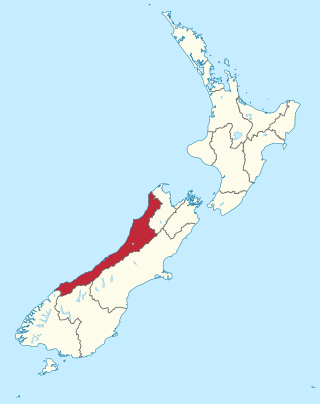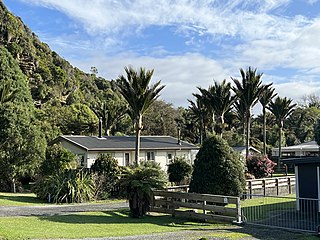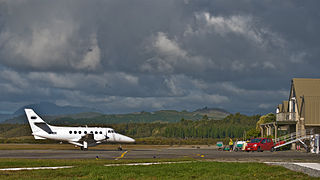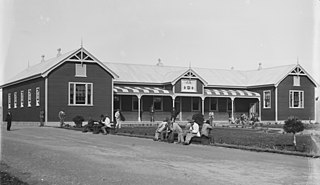
The Hokitika Wildfoods Festival is an annual event held in early March in Hokitika, New Zealand. Its main attraction is an array of unusual foods, including huhu grubs, lamb's testicles, and horse semen.

The Hokitika Wildfoods Festival is an annual event held in early March in Hokitika, New Zealand. Its main attraction is an array of unusual foods, including huhu grubs, lamb's testicles, and horse semen.

The Wildfoods festival was started in 1990 by Hokitika local Claire Bryant, a producer of gorse-flower and rose-petal wine, who wanted to celebrate the flavours and produce of the West Coast. [1] [2] The first festival in March 1990 coincided with Hokitika's 125th anniversary and was run by Heritage Hokitika. [3] It took place in a newly-developed heritage area on Gibson Quay in downtown Hokitika. [3] The first Wildfoods had 30 stalls, and attracted 1800 people. [1] [4] Alison Holst was the celebrity judge. [3]
Wildfoods has traditionally been run on the second Saturday in March, the driest time on the West Coast. [1] [5] The weather has generally been fine, but in the third festival in 1992 a squall blew down the festival tent. [3] By that year visitor numbers had increased to 3,800, so in 1993 Wildfoods moved to its current venue of Cass Square, which has a capacity of 10,000. [3] [6] [7] In 1994 for the first time the festival was opened by the West Coast Member of Parliament, Damien O'Connor, rather than the Mayor of Westland. One councillor decried the involvement of a "foreigner" as "propaganda by the Labour Party". [8]
The 1991 and 1992 festivals had been run by the South Westland Community Activities Trust, but Westland District Council took over the operation of the fourth festival in 1993. [3] Mike Keenan was appointed as festival coordinator, assisted by Lance Rae and a voluntary festival committee (numbering 17 by 2005). [3] [9] The use of festival currency stopped after 1994, and by 1995 the event, sponsored by Monteith's, had expanded to cover Cass Square. [3] By the next year the festival had reached its peak number of 90 different stalls. [3] Westpower, the other major sponsor since 1990, was taken over by Trustpower in 1999. [3]
| Number | Year | Numbers | Stalls | Profit/loss |
|---|---|---|---|---|
| 1 | 1990 | 1,800 [5] | 30 [1] | |
| 2 | 1991 | 2,000 [3] | 37 [3] | |
| 3 | 1992 | 3,800 [3] | ||
| 4 | 1993 | 6,500 [3] | ||
| 5 | 1994 | 7,840 [3] | ||
| 6 | 1995 | 8,527 [3] | ||
| 7 | 1996 | 11,000 [3] | 90 [3] | |
| 8 | 1997 | 13,500 [3] | ||
| 9 | 1998 | 14,600 [3] | ||
| 10 | 1999 | 14,300 [3] | ||
| 11 | 2000 | 16,140 [3] | ||
| 12 | 2001 | 19,200 [10] | ||
| 13 | 2002 | 20,663 [10] | $90,624 [10] | |
| 14 | 2003 | 22,466 [10] | 90 [11] | $85,225 [10] |
| 21 | 2010 | 13,500 [12] | 80+ [12] | |
| 22 | 2011 | 10,436 [11] | 65 [13] | |
| 23 | 2012 | 10,800 [14] | 53 [11] | |
| 24 | 2013 | 8,500 [15] | -$68,000 [15] | |
| 25 | 2014 | c. 6,300 [16] | 43 [16] | -$81,042 [17] |
| 26 | 2015 | 5,345 [18] | ||
| 27 | 2016 | 6,620 [19] | 50 [19] | $19,305 [17] |
| 28 | 2017 | < 6,700 [7] | 51 [7] | $12,000 [20] |
| 29 | 2018 | 8,000 [21] | 50 [21] | -$53,612 [20] |
| 30 | 2019 | 10,000 [22] | 50+ [22] | $20,000 [23] |
| 31 | 2020 | 7,000 [23] | ||
| 32 | 2021 | > 9,000 [24] | ||
| — | 2022 | postponed |
By 2003, after ten years of steady growth, Wildfoods Festival attendance peaked at 22,500 (Hokitika at the time had a population of just 3,500). [10] That year over 100 of whitebait and 19,000 litres of beer were sold. [25] Over half the visitors came from Canterbury (and 81 per cent from the South Island), only 2 per cent from Auckland, and 9 per cent from overseas. [10] At its height the festival attracted 25,000 under-age revellers, who smashed windows, lit bonfires on the beach, and left litter over central Hokitika; 20 were arrested, and there were calls for Wildfoods to be cancelled. [26] Subsequently ticket sales were capped at 15,000, [4] and a liquor ban was introduced downtown, with all alcohol being sold in plastic cups. [13] Sixty-eight arrests were made in 2012 for breaching the liquor ban (although none were at the festival site), [27] but in recent years arrests for disorderly behaviour were lower: fifteen in 2016, [16] eight in 2017. [7]
In 2005 the Wildfoods Festival received a New Zealand Tourism Award in the Innovation category. [9]
A 2012 study by BERL estimated the benefit of Wildfoods to the West Coast region as $6.5 million a year. [14] [20] The festival boosted accommodation nights in Hokitika at the end of the summer; before the recent explosion of Airbnb numbers in Hokitika, there was limited hotel/motel accommodation in Hokitika (approximately 600 people in 2003), [10] and many residents rented out private rooms to host the influx of tourists. [20] [28] Ten years after the last survey, over a quarter of the festival attendees now came from the North Island, 11 per cent were from Auckland, and 5 per cent from overseas. [14] Ninety per cent (9,700) were from outside the West Coast region, an unusually high proportion for a national festival. [11] The largest visitor age group was 21–29 year olds. [11] Each visitor stayed an average of 2.5 days and spent on average $540. [14] Around 60 community groups ran stalls or provide services to the festival for fund-raising purposes, raising over $110,000; the kitchen of the Karamea Community Hall, for example, was refurbished with the proceeds of their stall. [11] [7] [29] The festival was estimated to create 47 full-time-equivalent jobs. [14]
In 2016, after five years of losses, the festival again made a profit. [17] The festival had cut expenses by $120,000, reintroduced a pre-party at Hokitika Beach, and revived the after-party that had been cancelled in the preceding two years. [17] The Westland District Council had continued to run the festival, despite losses, because of the economic benefit it provided to local businesses and the community. [17]
After being organised by the Westland District Council for 29 years, Wildfoods was outsourced in 2019 to publicly-owned and Council-controlled organisation Destination Westland, who after some contention over whether the festival was a good financial risk have continued to run it. [20] [30] [23]
Mike Keenan ran the Wildfoods Festival for 21 years but was made redundant in 2014 when the Council disestablished its events department. [18] Subsequent managers were Ashley Cassin (2016), [31] Sarah Brown (2018), [21] and Amber Popaite of Destination Westland (2019). [21] [30]
In 2022 the Festival was postponed until the following year because of the COVID-19 pandemic in New Zealand. [24]

The Wildfoods Festival's distinctive identity comes from the range of unusual foods available. Its most notorious offerings include:
Other foods offered at the festival have included chicken feet, jellied fish eye shots, lamb tails, crocodile and kangaroo bites, baby octopus, fish heads, pig pizzle, sheep brain pâté, sweetbreads, wild pork, whitebait fritters, pāua, pipi, wasp larvae ice cream, deer and bull semen, gorse-flower wine, earthworms, possum, pig's trotters, mussels, venison, scallops, hāngī, crispy tarantulas, bovine colostrum milkshakes, pork-blood casserole, cow udders, seagull eggs, live grasshoppers, and whisky sausages. [4] [6] [12] [19] [15]
The prizewinning recipe at the first Wildfoods Festival was venison goulash, prepared by Pierre Esquilat of Hokitika's Cafe de Paris. [3] There are cooking demonstrations by celebrity chefs such as Ben Bayly and MasterChef NZ 2015 winner Tim Read. [31] Maggie Beer was the Festival celebrity chef in 1995, and Helen Jackson (who comes from Hokitika) in 1999. [3]
Dressing up in novelty costumes is common at Wildfoods, and the festival runs a Feral Fashion competition. [21] Musical entertainment has been provided by the New Zealand Army Band, the Black Seeds, [31] Salmonella Dub, [7] Elemeno P, [12] and local musicians such as the West Coast Kokatahi Band, Westland District Brass, and Hokitika Districts Country Music Club. [6] [21] A fireworks display ends the festival. [22]
The 1999 New Zealand feature film Magik and Rose , directed by Vanessa Alexander, is set before and during the Hokitika Wildfoods Festival. It was partly shot at the 10th festival in 1999 (guest presenter Gary McCormick makes a cameo). [33] The film's world premiere was at Hokitika's Regent Theatre at the 2000 festival. [3]

The West Coast is a region of New Zealand on the west coast of the South Island that is administered by the West Coast Regional Council, and is known co-officially as Te Tai Poutini. It comprises the territorial authorities of Buller District, Grey District and Westland District. The principal towns are Westport, Greymouth and Hokitika. The region, one of the more remote areas of the country, is also the most sparsely populated. With a population of just 32,900 people, the West Coast is the least populous region in New Zealand. The population in the region grew by 0.4% over the year to July 2023.

Punakaiki is a small village on the West Coast of the South Island of New Zealand. It is located between Westport and Greymouth on State Highway 6, the only through-road on the West Coast. Punakaiki is immediately adjacent to Paparoa National Park, and is also the access point for a popular visitor attraction, the Pancake Rocks and Blowholes.

Hokitika is a town in the West Coast region of New Zealand's South Island, 40 kilometres (25 mi) south of Greymouth, and close to the mouth of the Hokitika River. It is the seat and largest town in the Westland District. The town's estimated population is 3,120 as of June 2023.

The Taramakau River is a river of the West Coast Region of the South Island of New Zealand. It rises in the Southern Alps / Kā Tiritiri o te Moana near Harper Pass, 80 kilometres (50 mi) due east of Hokitika, and runs westward for 75 kilometres (47 mi) into the Tasman Sea 15 kilometres (9.3 mi) south of Greymouth.

Ross is a small town located in the Westland District on the West Coast of New Zealand's South Island, 27 kilometres (17 mi) south-west of Hokitika and 46 kilometres (29 mi) north-east of Hari Hari by road.

The Westland petrel(Procellaria westlandica),, also known as the Westland black petrel, is a moderately large seabird in the petrel family Procellariidae, that is endemic to New Zealand. Described by Robert Falla in 1946, it is a stocky bird weighing approximately 1,100 grams (39 oz), and is one of the largest of the burrowing petrels. It is a dark blackish-brown colour with black legs and feet. It has a pale yellow bill with a dark tip.

The huhu beetle is a longhorn beetle endemic to New Zealand. It is the heaviest beetle found in New Zealand.

Westland District is a territorial authority district on the West Coast of New Zealand's South Island. It is administered by the Westland District Council. The district's population is 8,940.

Hokitika Aerodrome is a small, uncontrolled aerodrome located 1.9 km north east of Hokitika in the suburb of Seaview on the West Coast of the South Island of New Zealand. It is also the closest domestic airport with scheduled flights to the town of Greymouth 40 km further north, the largest settlement on the coast.

Franz Josef / Waiau is a small town in the West Coast region of the South Island of New Zealand. Whataroa is 32 kilometres (20 mi) to the north-east, and the township of Fox Glacier is 23 kilometres (14 mi) to the south-west. The Waiho River runs from the Franz Josef Glacier to the south, through the town, and into the Tasman Sea to the north-west.

Westland Milk Products is a dairy company based in Hokitika, New Zealand. It has been owned by Chinese dairy company Yili Group since 2019. It is the third-equal largest dairy processor in New Zealand with a 3.4% market share.

The Seaview Asylum was a psychiatric hospital located to the north of Hokitika, in the West Coast Region of New Zealand's South Island, adjacent to the former Westland Hospital. Open from 1872 to 2009, Seaview trained psychiatric nurses and was once the town's biggest employer.

Maureen Helena Pugh is a New Zealand politician. She was the mayor of Westland District from 2004 to 2013. She first became a Member of parliament for the National Party in 2016, leaving Parliament in 2017 and returning in 2018. She was initially a list MP, before winning the West Coast-Tasman electorate in 2023.

The West Coast Wilderness Trail has been funded as one of the projects of the New Zealand Cycle Trail. Once complete, the 139 kilometres (86 mi) track will connect Greymouth in the north with Ross in the south.

Development West Coast (DWC) is a charitable trust that operates in the West Coast region of New Zealand. DWC is the economic development agency and regional tourism organisation for the region.

Hokitika Museum is a museum in Hokitika on the West Coast of the South Island in New Zealand, and is the West Coast's largest museum and archive. It is housed in the historic Hokitika Carnegie Library building. Exhibitions include information about the gold rush and the unique West Coast stone pounamu (greenstone) and its value to Māori. The museum also holds a significant photographic collection. Seismic strengthening requirements closed the museum in September 2019. According to the Westland District Council Web site as of December 2021 the museum had not yet reopened.

Hokitika Gorge and the surrounding Hokitika Gorge Scenic Reserve are a major tourist destination some 33 kilometres (21 mi) or 40 minutes drive inland from Hokitika, New Zealand. Since August 2020, a second suspension bridge over the Hokitika River at the gorge provides the opportunity for a round track.

The Westland Pioneers' Memorial is a statue in Hokitika, New Zealand, commemorating the pioneer settlers of Westland. Unveiled in 1914, the statue had its right arm broken off in 2009 and was subsequently dubbed Venus de Hokitika. The memorial was relocated in 2016 from its original location on the side of State Highway 6 to the centre of a roundabout in one of Hokitika's main streets.

The West Coast Wildlife Centre is a kiwi-rearing facility in Franz Josef, New Zealand. A public-private partnership with the Department of Conservation and Te Rūnunga o Makaawhio of Ngāi Tahu, it hatches eggs of the kiwi species rowi and Haast tokoeka retrieved from the wild. It rears the chicks until they are large enough for transfer to outdoor enclosures as part of Operation Nest Egg. More than 50 per cent of all living rowi were hatched at the Wildlife Centre. It is also a tourist attraction with several captive tuatara, museum displays, and tours of the rearing facility.
Allan John Birchfield is a coal and gold miner from the South Island's West Coast of New Zealand. He is a West Coast Regional Councillor who served as chairperson from 2019 to 2023. He is known for his climate change denial.